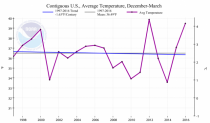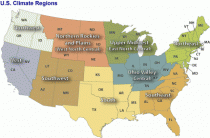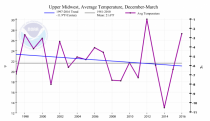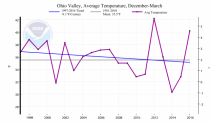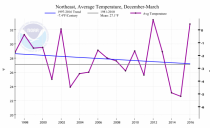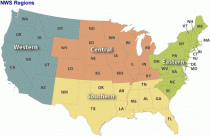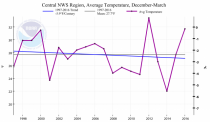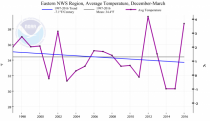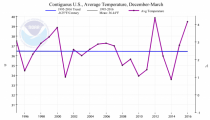Even with warm 2016/17 winter, US 20+ year trends are still down
Joseph D’Aleo, CCM, AMS Fellow
This winter has started in December with some frigid cold, especially the central. Here is the last 7 days and the forecast the next 5 days (maps courtesy of Weatherbell.com).
Though many have argued the so called ‘pause’ was clearly over, it appears not. The pop in 2015/16 was related to El Nino.
NCDC (now NCEI) has the Climate at a Glance tool I frequently use for temperature and precipitation trend. I have used it in recent years to examine trends in winters the last 18 to 20 years. It was argued a few years back the cooling it showed was biased by the significant El Nino of 1997/98. Even after the (1) new NOAA methodology (removal of UHI adjustment, TOBS. homogenization) that made 1997/98 less warm and (2) the 2011/12 and 2015/16 warm spikes (perhaps slightly enhanced by the changes), what was called the pause (really a cooling trend) is still there in the last 20 year period for December to March.
For the nation, we have seen a cooling rate of -1.63F/century.
The NCEI CAAG site allows you to look at regional changes. I looked first at U.S. Climate Regions (Upper Midwest/Great Lakes, Ohio Valley and Northeast.
The cooling was greatest in the Upper Midwest (an amazing rate of -11.9F/century).
The Ohio Valley has cooled at a rate of – 9.1F/century.
The northeast has cooled at a rate of – 7.4F/century for December to March periods
Then I looked at larger NWS regions (administrative):
The large 14 state central region shows a cooling rate of -5.9F/century.
The large 16 state Eastern Region a cooling of -7.1F/century even with the 2011/12 and 2015/16 spikes.
Despite some ups and downs, we expect this year will be colder than last winter and keep the trend going.
To see how far back I could go and get a negative trend, I went to 1995 for the CONUS and found no warming trend (a not statistically significant cooling of 0.25F/century) the last 22 years.
Though the jump in major snows in the east was attributed in the media to global warming and resulting more moisture. I would argue the land cooling is responsible. Sellers back in the middle 1900’s speculated snow would increase after warm periods and the increased snowcover would initiate or enhance any cooling that followed.

_thumb.png)
_thumb.png)
